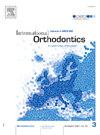Management of juvenile idiopathic arthritis in a 15-year-old patient: A digitally designed Herbst appliance combined with rapid maxillary expansion for transversal and sagittal correction
IF 1.9
Q2 DENTISTRY, ORAL SURGERY & MEDICINE
引用次数: 0
Abstract
Juvenile idiopathic arthritis (JIA) is the most frequent systemic inflammatory disease involving temporomandibular joints in children. The reported prevalence of temporomandibular joint involvement in patients with juvenile idiopathic arthritis varies from 17% to 87% depending on the population studied, the subtypes, and the method for diagnosis. A 15-year-old girl was referred to the Department of Oral and Maxillofacial Surgery and the Department of Orthodontics of Parma University, Italy, for the evaluation and treatment of a three-dimensional facial deformity secondary to mandibular hypoplasia. The treatment strategy involved the use of a digitally designed Herbst appliance to promote mandibular growth and address facial asymmetry, occlusal plane deviation, and dental malocclusion. This phase was followed by fixed orthodontic therapy to finalize dental alignment and ensure occlusal stability. At the conclusion of the treatment, the patient demonstrated substantial functional and aesthetic improvements, with stability maintained during a three-year follow-up period. This case underscores the efficacy of combining functional therapeutic protocols with advanced digital technologies in the multidisciplinary management of JIA-associated dentofacial anomalies, offering a less invasive alternative to surgical interventions.
15岁青少年特发性关节炎患者的治疗:数字设计的Herbst矫治器结合快速上颌扩张进行横向和矢状面矫正。
青少年特发性关节炎(JIA)是儿童颞下颌关节最常见的全身性炎症性疾病。据报道,青少年特发性关节炎患者的颞下颌关节受累率从17%到87%不等,这取决于所研究的人群、亚型和诊断方法。一名15岁的女孩被转介到意大利帕尔马大学口腔颌面外科和正畸科,以评估和治疗继发于下颌发育不全的三维面部畸形。治疗策略包括使用数字设计的Herbst矫治器来促进下颌生长,解决面部不对称、咬合平面偏差和牙合错。这个阶段之后是固定正畸治疗,以确定牙齿排列和确保咬合稳定。在治疗结束时,患者表现出实质性的功能和美学改善,并在三年的随访期间保持稳定。该病例强调了将功能治疗方案与先进的数字技术相结合在jia相关牙面异常的多学科管理中的有效性,为手术干预提供了一种侵入性更小的选择。
本文章由计算机程序翻译,如有差异,请以英文原文为准。
求助全文
约1分钟内获得全文
求助全文
来源期刊

International Orthodontics
DENTISTRY, ORAL SURGERY & MEDICINE-
CiteScore
2.50
自引率
13.30%
发文量
71
审稿时长
26 days
期刊介绍:
Une revue de référence dans le domaine de orthodontie et des disciplines frontières Your reference in dentofacial orthopedics International Orthodontics adresse aux orthodontistes, aux dentistes, aux stomatologistes, aux chirurgiens maxillo-faciaux et aux plasticiens de la face, ainsi quà leurs assistant(e)s. International Orthodontics is addressed to orthodontists, dentists, stomatologists, maxillofacial surgeons and facial plastic surgeons, as well as their assistants.
 求助内容:
求助内容: 应助结果提醒方式:
应助结果提醒方式:


